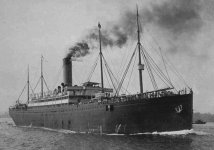ShipwreckHunter
Jr. Member
- May 15, 2015
- 38
- 137
- Detector(s) used
- Garrett Master Hunter
GTI 2500
Infinium LS
Sea Hunter II
Pro-Pointer AT
- Primary Interest:
- Shipwrecks
I am looking for someone who may have in their possession pictures taken by a relative or friend who traveled on the RMS Republic.. I would love to have copies of any pictures taken before the ship sank in 1909. The RMS Republic was a steam-powered ocean liner built in 1903 by Harland and Wolff in Belfast, and lost at sea in a collision six years later while sailing for the White Star Line. A CQD distress call was issued on the new Marconi radio device, the first recorded, resulting in the saving of around 1500 lives. Known as the "Millionaires' Ship" on account of the number of well-known and immensely rich Americans who traveled by her, she was often referred to as a "palatial liner." She was the flagship of White Star Line's Boston service and was one of the ten largest passenger liners in the world at the time. If someone was to have in their possession a set of blueprints for this ship, I may be able to have them compensated financially for a set of copies... Republic was insured by Morgan's IMM, so perhaps a former employee has a set somewhere .. Please contact me at [email protected] if you have pictures or information on a set of blueprints... All information will be turned over to Martin Bayerle and the "Billion Dollar Wreck" project ... Thank you.. Gene Birdsong





